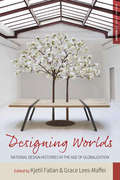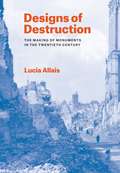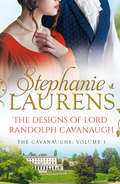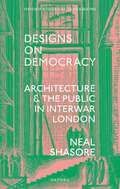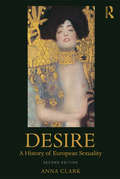- Table View
- List View
Designing West Africa: Prelude to 21st Century Calamity
by P. SchwabMany African nations are now described as 'fourth world nations', ones which essentially have no future. How could this have happened? Through the scope of the 1960's, the first decade of African independence, Peter Schwab presents a compelling and provocative answer to this question. Designing West Africa tells the story of a pivotal decade in African history, when the fate of the continent was decided. Focusing on the six most visible leaders of the period - painting detailed portraits of them both as leaders and as people - Schwab looks at how Africa served as a ground to play out larger international conflicts, namely the Cold War. He does not fall back on blaming non-African involvement for the failure to build a visible leadership for the continent; rather he critiques the African leaders themselves for their individual failings.
Designing Worlds: National Design Histories in an Age of Globalization (Making Sense of History #24)
by 9781785331565From consumer products to architecture to advertising to digital technology, design is an undeniably global phenomenon. Yet despite their professed transnational perspective, historical studies of design have all too often succumbed to a bias toward Western, industrialized nations. This diverse but rigorously curated collection recalibrates our understanding of design history, reassessing regional and national cultures while situating them within an international context. Here, contributors from five continents offer nuanced studies that range from South Africa to the Czech Republic, all the while sensitive to the complexities of local variation and the role of nation-states in identity construction.
Designology: Studies on Planning for Action (Praxiology)
by Wojciech W. Gasparski Tufan OrelThe more complex a human action is, the greater the need to formulate a plan of action, devise a method of implementation, and evaluate its execution. Such preparation is called design or planning, and can be defined as a conceptual preparation for action. Design and planning by themselves are so complex and important that they need informed preparation, which calls for systematic designological studies.This volume brings together original contributions of researchers and practitioners in design theory, design research, and design studies. Its main purpose is to highlight the possibilities of the discipline of designology. Doing and thinking, or thinking and doing, whatever the order, are intertwined. That is why praxiology, the science of action, defines design as a conceptual preparation of action.Included here are contributions from Jack Brzezinski, Eduardo Corte-Real, Nigel Cross, Michel Faucheux, Joelle Forest, Wojciech W. Gasparski, Ioannes B. Kapelouzos, Thorbjoern Mann, Tom Maver, Tarkko Oksala, Tufan Orel, Sevil Saryldz, and Ladislav Tondl. Designology is the latest volume in Transaction's highly regarded Praxiology series.
Designology: Studies on Planning for Action (Praxiology)
by Wojciech W. Gasparski Tufan OrelThe more complex a human action is, the greater the need to formulate a plan of action, devise a method of implementation, and evaluate its execution. Such preparation is called design or planning, and can be defined as a conceptual preparation for action. Design and planning by themselves are so complex and important that they need informed preparation, which calls for systematic designological studies.This volume brings together original contributions of researchers and practitioners in design theory, design research, and design studies. Its main purpose is to highlight the possibilities of the discipline of designology. Doing and thinking, or thinking and doing, whatever the order, are intertwined. That is why praxiology, the science of action, defines design as a conceptual preparation of action.Included here are contributions from Jack Brzezinski, Eduardo Corte-Real, Nigel Cross, Michel Faucheux, Joelle Forest, Wojciech W. Gasparski, Ioannes B. Kapelouzos, Thorbjoern Mann, Tom Maver, Tarkko Oksala, Tufan Orel, Sevil Saryldz, and Ladislav Tondl. Designology is the latest volume in Transaction's highly regarded Praxiology series.
Designs for Street Fronts, Suburban Houses and Cottages (Dover Architecture)
by C. C. Miller M. F. CummingsExcellent sourcebook includes elevations of building fronts as well as enlarged drawings of architectural elements incorporated in these facades: residential entrances, cornices, a curved roof, dormer window, and much more. Indispensable archive for preservationists, restorationists, architectural historians, and urban archaeologists. 714 illustrations on 52 plates.
Designs of Destruction: The Making of Monuments in the Twentieth Century
by Lucia AllaisThe twentieth century was the most destructive in human history, but from its vast landscapes of ruins was born a new architectural type: the cultural monument. In the wake of World War I, an international movement arose which aimed to protect architectural monuments in large numbers, and regardless of style, hoping not only to keep them safe from future conflicts, but also to make them worthy of protection from more quotidian forms of destruction. This movement was motivated by hopeful idealism as much as by a pragmatic belief in bureaucracy. An evolving group—including architects, intellectuals, art historians, archaeologists, curators, and lawyers—grew out of the new diplomacy of the League of Nations. During and after World War II, it became affiliated with the Allied Military Government, and was eventually absorbed by the UN as UNESCO. By the 1970s, this organization had begun granting World Heritage status to a global register of significant sites—from buildings to bridges, shrines to city centers, ruins to colossi. Examining key episodes in the history of this preservation effort—including projects for the Parthenon, for the Cathedral of St-Lô, the temples of Abu Simbel, and the Bamyian Buddahs —Lucia Allais demonstrates how the group deployed the notion of culture to shape architectural sites, and how architecture in turn shaped the very idea of global culture. More than the story of an emergent canon, Designs of Destruction emphasizes how the technical project of ensuring various buildings’ longevity jolted preservation into establishing a transnational set of codes, values, practices. Yet as entire nations’ monumental geographies became part of survival plans, Allais also shows, this paradoxically helped integrate technologies of destruction—from bombs to bulldozers—into cultural governance. Thus Designs of Destruction not only offers a fascinating narrative of cultural diplomacy, based on extensive archival findings; it also contributes an important new chapter in the intellectual history of modernity by showing the manifold ways architectural form is charged with concretizing abstract ideas and ideals, even in its destruction.
Designs of Destruction: The Making of Monuments in the Twentieth Century
by Lucia AllaisThe twentieth century was the most destructive in human history, but from its vast landscapes of ruins was born a new architectural type: the cultural monument. In the wake of World War I, an international movement arose which aimed to protect architectural monuments in large numbers, and regardless of style, hoping not only to keep them safe from future conflicts, but also to make them worthy of protection from more quotidian forms of destruction. This movement was motivated by hopeful idealism as much as by a pragmatic belief in bureaucracy. An evolving group—including architects, intellectuals, art historians, archaeologists, curators, and lawyers—grew out of the new diplomacy of the League of Nations. During and after World War II, it became affiliated with the Allied Military Government, and was eventually absorbed by the UN as UNESCO. By the 1970s, this organization had begun granting World Heritage status to a global register of significant sites—from buildings to bridges, shrines to city centers, ruins to colossi. Examining key episodes in the history of this preservation effort—including projects for the Parthenon, for the Cathedral of St-Lô, the temples of Abu Simbel, and the Bamyian Buddahs —Lucia Allais demonstrates how the group deployed the notion of culture to shape architectural sites, and how architecture in turn shaped the very idea of global culture. More than the story of an emergent canon, Designs of Destruction emphasizes how the technical project of ensuring various buildings’ longevity jolted preservation into establishing a transnational set of codes, values, practices. Yet as entire nations’ monumental geographies became part of survival plans, Allais also shows, this paradoxically helped integrate technologies of destruction—from bombs to bulldozers—into cultural governance. Thus Designs of Destruction not only offers a fascinating narrative of cultural diplomacy, based on extensive archival findings; it also contributes an important new chapter in the intellectual history of modernity by showing the manifold ways architectural form is charged with concretizing abstract ideas and ideals, even in its destruction.
Designs of Destruction: The Making of Monuments in the Twentieth Century
by Lucia AllaisThe twentieth century was the most destructive in human history, but from its vast landscapes of ruins was born a new architectural type: the cultural monument. In the wake of World War I, an international movement arose which aimed to protect architectural monuments in large numbers, and regardless of style, hoping not only to keep them safe from future conflicts, but also to make them worthy of protection from more quotidian forms of destruction. This movement was motivated by hopeful idealism as much as by a pragmatic belief in bureaucracy. An evolving group—including architects, intellectuals, art historians, archaeologists, curators, and lawyers—grew out of the new diplomacy of the League of Nations. During and after World War II, it became affiliated with the Allied Military Government, and was eventually absorbed by the UN as UNESCO. By the 1970s, this organization had begun granting World Heritage status to a global register of significant sites—from buildings to bridges, shrines to city centers, ruins to colossi. Examining key episodes in the history of this preservation effort—including projects for the Parthenon, for the Cathedral of St-Lô, the temples of Abu Simbel, and the Bamyian Buddahs —Lucia Allais demonstrates how the group deployed the notion of culture to shape architectural sites, and how architecture in turn shaped the very idea of global culture. More than the story of an emergent canon, Designs of Destruction emphasizes how the technical project of ensuring various buildings’ longevity jolted preservation into establishing a transnational set of codes, values, practices. Yet as entire nations’ monumental geographies became part of survival plans, Allais also shows, this paradoxically helped integrate technologies of destruction—from bombs to bulldozers—into cultural governance. Thus Designs of Destruction not only offers a fascinating narrative of cultural diplomacy, based on extensive archival findings; it also contributes an important new chapter in the intellectual history of modernity by showing the manifold ways architectural form is charged with concretizing abstract ideas and ideals, even in its destruction.
Designs of Destruction: The Making of Monuments in the Twentieth Century
by Lucia AllaisThe twentieth century was the most destructive in human history, but from its vast landscapes of ruins was born a new architectural type: the cultural monument. In the wake of World War I, an international movement arose which aimed to protect architectural monuments in large numbers, and regardless of style, hoping not only to keep them safe from future conflicts, but also to make them worthy of protection from more quotidian forms of destruction. This movement was motivated by hopeful idealism as much as by a pragmatic belief in bureaucracy. An evolving group—including architects, intellectuals, art historians, archaeologists, curators, and lawyers—grew out of the new diplomacy of the League of Nations. During and after World War II, it became affiliated with the Allied Military Government, and was eventually absorbed by the UN as UNESCO. By the 1970s, this organization had begun granting World Heritage status to a global register of significant sites—from buildings to bridges, shrines to city centers, ruins to colossi. Examining key episodes in the history of this preservation effort—including projects for the Parthenon, for the Cathedral of St-Lô, the temples of Abu Simbel, and the Bamyian Buddahs —Lucia Allais demonstrates how the group deployed the notion of culture to shape architectural sites, and how architecture in turn shaped the very idea of global culture. More than the story of an emergent canon, Designs of Destruction emphasizes how the technical project of ensuring various buildings’ longevity jolted preservation into establishing a transnational set of codes, values, practices. Yet as entire nations’ monumental geographies became part of survival plans, Allais also shows, this paradoxically helped integrate technologies of destruction—from bombs to bulldozers—into cultural governance. Thus Designs of Destruction not only offers a fascinating narrative of cultural diplomacy, based on extensive archival findings; it also contributes an important new chapter in the intellectual history of modernity by showing the manifold ways architectural form is charged with concretizing abstract ideas and ideals, even in its destruction.
The Designs Of Lord Randolph Cavanaugh: The Governess Game / Mistress At Midnight / Scars Of Betrayal / Rake Most Likely To Rebel / Rake Most Likely To Thrill / The Designs Of Lord Randolph Cavanaugh (Hq Fiction Ebook Ser. #1)
by Stephanie Laurens#1 New York Times bestselling author Stephanie Laurens returns with a new series that captures the simmering desires and intrigues of early Victorians as only she can. ‘Stephanie Laurens’ heroines are marvelous tributes to Georgette Heyer: feisty and strong.’ Cathy Kelly
Designs on Democracy: Architecture and the Public in Interwar London (Oxford Historical Monographs)
by Neal ShasoreDesigns on Democracy examines a pivotal period in the formation of the modern profession of architecture in Britain. It shows how architects sought to meet the newly articulated demands of a mass democracy in the wake of the First World War. It does so by providing a vivid picture of architectural culture in interwar London, the Imperial metropolis, drawing on histories of design, practice, professionalism, and representation. Most accounts of this period tend to deal exclusively with the emergence of Modernism; this study takes a different approach, encompassing a much broader perspective on the liberal professional consensus that held sway, including architecture's mainstream and its so-called avant-garde. Readers will encounter a number of unexpected narratives, episodes, and projects: from the British Empire Exhibition at Wembley to the rebuilding of Waterloo Bridge; from the impact of the Great Slump to the passing of the first Architects Registration Act (1931); from Trystan Edwards's radical housing campaigns to the Londoners' League's unorthodox preservationism. Pulling in a range of evidence and sources - periodicals, exhibitions, photographs, and films, alongside architecture - it evokes architectural culture by listening carefully to the tenor of its discourse. Architecture's public realm is thus analysed through sometimes surprising phrases: 'manners' to understand ideals of public propriety, 'vigilance' to explore public proprietorship, 'slump' to contextualise the emergence of public relations, 'machine-craft' to understand the forging of public institutions. The volume spans the excitable discussions about the reconstruction of the profession for a democratic age after WWI, to reconstruction and planning following WWII, providing an ambitious revision of how we can understand twentieth century architecture in Britain.
Designs on Democracy: Architecture and the Public in Interwar London (Oxford Historical Monographs)
by Neal ShasoreDesigns on Democracy examines a pivotal period in the formation of the modern profession of architecture in Britain. It shows how architects sought to meet the newly articulated demands of a mass democracy in the wake of the First World War. It does so by providing a vivid picture of architectural culture in interwar London, the Imperial metropolis, drawing on histories of design, practice, professionalism, and representation. Most accounts of this period tend to deal exclusively with the emergence of Modernism; this study takes a different approach, encompassing a much broader perspective on the liberal professional consensus that held sway, including architecture's mainstream and its so-called avant-garde. Readers will encounter a number of unexpected narratives, episodes, and projects: from the British Empire Exhibition at Wembley to the rebuilding of Waterloo Bridge; from the impact of the Great Slump to the passing of the first Architects Registration Act (1931); from Trystan Edwards's radical housing campaigns to the Londoners' League's unorthodox preservationism. Pulling in a range of evidence and sources - periodicals, exhibitions, photographs, and films, alongside architecture - it evokes architectural culture by listening carefully to the tenor of its discourse. Architecture's public realm is thus analysed through sometimes surprising phrases: 'manners' to understand ideals of public propriety, 'vigilance' to explore public proprietorship, 'slump' to contextualise the emergence of public relations, 'machine-craft' to understand the forging of public institutions. The volume spans the excitable discussions about the reconstruction of the profession for a democratic age after WWI, to reconstruction and planning following WWII, providing an ambitious revision of how we can understand twentieth century architecture in Britain.
Designs on the Past: How Hollywood Created the Ancient World
by Lloyd Llewellyn-JonesThe first 50-year retrospective of the most tumultuous year of the 1960s for activism and radical politics
Designs on the Past: How Hollywood Created the Ancient World (Screening Antiquity Ser.)
by Lloyd Llewellyn-JonesExplores how a new generation are redefining what it means to be a Muslim in Britain today
The Desirable Duchess: Regency Royal 14 (Regency Royal)
by M.C. BeatonLovely Alice Lacey was a true Incomparable, and her marriage to the Duke of Ferrant was the event of the Season. But almost none realized, however, that Alice was secretly in love with someone else - or that she had confided her feelings to a clever talking mynah bird who determined to announce these intimacies at the moment of the couple's wedding!Now the gossip mongers were relentless. Alice's marriage had started out and remained cold and impersonal, and her new husband was already rumored to be taken with another woman.Before she even realized what was happening, Alice found herself in world of opposites: she found out that the man she had thought she loved was something other than what he seemed, and the man she had married was something far more than she'd hoped. Her last hope and redemption had to be convincing the man she had wed that they were in love.
A Desirable Husband (Mills And Boon Historical Ser.)
by Mary NicholsLady Esme Vernley's unconventional first meeting with a handsome gentleman in Hyde Park has damned him in the eyes of her family.
Desire: A History of European Sexuality
by Anna Clark‘… the rich range of historical information that Clark weaves into her chapters... makes this ambitious overview of sex in Europe a highly accessible and successful endeavour.’ – Times Higher Education Supplement 'Provides a valuable overview of the history of sexuality in Europe since classical antiquity, synthesising as it does a mass of studies of specific regions and periods which have appeared during the last two decades.' Lesley Hall, Wellcome Library, UK Desire: A History of European Sexuality is a sweeping survey of sexuality in Europe from the Greeks to the present day. It traces two concepts of sexual desire that have competed in European history: desire as dangerous, polluting, and disorderly; and desire as creative, transcendent, even revolutionary. This book follows these changing attitudes toward sexuality through the major turning points of European history. Written in a lively and engaging style, the book contains many fascinating anecdotes drawing on a rich array of sources including poetry, novels, pornography and film as well as court records, autobiographies and personal letters. While Anna Clark builds on the work of dozens of historians, she also takes a fresh approach and introduces the concepts of twilight moments and sexual economies. Desire integrates the history of heterosexuality with same-sex desire, and focuses on the emotions of love as well as the passions of lust, the politics of sex as well as the personal experiences.
Desire: A History of European Sexuality
by Anna Clark‘… the rich range of historical information that Clark weaves into her chapters... makes this ambitious overview of sex in Europe a highly accessible and successful endeavour.’ – Times Higher Education Supplement 'Provides a valuable overview of the history of sexuality in Europe since classical antiquity, synthesising as it does a mass of studies of specific regions and periods which have appeared during the last two decades.' Lesley Hall, Wellcome Library, UK Desire: A History of European Sexuality is a sweeping survey of sexuality in Europe from the Greeks to the present day. It traces two concepts of sexual desire that have competed in European history: desire as dangerous, polluting, and disorderly; and desire as creative, transcendent, even revolutionary. This book follows these changing attitudes toward sexuality through the major turning points of European history. Written in a lively and engaging style, the book contains many fascinating anecdotes drawing on a rich array of sources including poetry, novels, pornography and film as well as court records, autobiographies and personal letters. While Anna Clark builds on the work of dozens of historians, she also takes a fresh approach and introduces the concepts of twilight moments and sexual economies. Desire integrates the history of heterosexuality with same-sex desire, and focuses on the emotions of love as well as the passions of lust, the politics of sex as well as the personal experiences.
Desire: A History of European Sexuality
by Anna ClarkA sweeping survey of sexuality in Europe from the Greeks to the present, Desire: A History of European Sexuality follows changing attitudes to two major concepts of sexual desire – desire as dangerous, polluting, and disorderly, and desire as creative, transcendent, even revolutionary – through the major turning points of European history. Chronological in structure, and wide ranging in scope, Desire addresses such topics as sex in ancient Judaism, Christianity, and Islam, sexual contact and culture clash in Spain and colonial Mesoamerica, new attitudes toward sexuality in the seventeenth and eighteenth centuries, and sex in Bolshevik Russia and Nazi Germany. The book introduces the concept of "twilight moments" to describe activities seen as shameful or dishonorable, but which were tolerated when concealed by shadows, and integrates the history of heterosexuality with same-sex desire, as well as exploring the emotions of love and lust as well as the politics of sex and personal experiences. This new edition has been updated to include a new chapter on sex and imperialism and expanded discussions of Islam and trans issues. Drawing on a rich array of sources, including poetry, novels, pornography, and film, as well as court records, autobiographies, and personal letters, and written in a lively, engaging style, Desire remains an essential resource for scholars and students of the history of European sexuality, as well as women’s and gender history, social and cultural history and LGBTQ history.
Desire: A History of European Sexuality
by Anna ClarkA sweeping survey of sexuality in Europe from the Greeks to the present, Desire: A History of European Sexuality follows changing attitudes to two major concepts of sexual desire – desire as dangerous, polluting, and disorderly, and desire as creative, transcendent, even revolutionary – through the major turning points of European history. Chronological in structure, and wide ranging in scope, Desire addresses such topics as sex in ancient Judaism, Christianity, and Islam, sexual contact and culture clash in Spain and colonial Mesoamerica, new attitudes toward sexuality in the seventeenth and eighteenth centuries, and sex in Bolshevik Russia and Nazi Germany. The book introduces the concept of "twilight moments" to describe activities seen as shameful or dishonorable, but which were tolerated when concealed by shadows, and integrates the history of heterosexuality with same-sex desire, as well as exploring the emotions of love and lust as well as the politics of sex and personal experiences. This new edition has been updated to include a new chapter on sex and imperialism and expanded discussions of Islam and trans issues. Drawing on a rich array of sources, including poetry, novels, pornography, and film, as well as court records, autobiographies, and personal letters, and written in a lively, engaging style, Desire remains an essential resource for scholars and students of the history of European sexuality, as well as women’s and gender history, social and cultural history and LGBTQ history.
Desire and Deception: A Rouge Regency Romance
by Nicole JordanA sweeping historical romance, from Nicole Jordan, the New York Times bestselling authorFaced with the prospect of a forced marriage, the young Lauren DeVries is anxious to flee London and seeks passage to America. Only Captain Jason Stuart, the man who can offer her this, is also the man she is desperately trying to avoid. Stuart is willing to take her aboard his ship, but only in exchange for a night of wild abandon. Can Lauren resist the seductive rogue and still get what she wants?Rouge romance - the best historical romance novels, perfect for fans of Georgette Heyer.
Desire and Disunity: Christian Communities and Sexual Norms in the Late Antique West (Studies in Medieval and Early Modern Belief and Culture)
by Ulriika VihervalliAn Open Access edition will be available on publication thanks to the kind sponsorship of the libraries participating in the Jisc Open Access Community Framework OpenUP initiative. Desire and Disunity explores the struggles of Christianising late ancient sexuality in the late Roman West. Through an examination of fourth to sixth century sermons, letters, laws, and treatises in Latin-speaking communities, the difficulties of late antique clerics in moving ascetically influenced sexual ideals into wider practice become evident. Western clerics faced challenges on several fronts: the dedication and devoutness of lay Christians varied, while the military-political upheavals of the fifth century created new challenges and opportunities for influencing one’s flock. Furthermore, Roman sexual norms continued to inform the thinking of many clerics and lay figures alike, even when in opposition to more scripturally based moral reasoning. Problems of bigamy, concubinage, sex work, incest, homosexual acts, adultery, and more troubled western Christian communities, with contradicting rules and traditions on what was acceptable and what was not. What reach did elite clerical perspectives on sexual norms have amongst the non-elite? How did clerics navigate tensions between the idealisation of Christian communal purity and the actions of congregants that fell short of these ideals? What influenced clerical perceptions of sex and how did they articulate these ideas to their audiences? Clerical sources of this time reflect these challenges as well as varying church attempts to reform the sex lives of their congregants – and, indeed, church failure in doing so.
Desire and Disunity: Christian Communities and Sexual Norms in the Late Antique West (Studies in Medieval and Early Modern Belief and Culture)
by Ulriika VihervalliAn Open Access edition will be available on publication thanks to the kind sponsorship of the libraries participating in the Jisc Open Access Community Framework OpenUP initiative. Desire and Disunity explores the struggles of Christianising late ancient sexuality in the late Roman West. Through an examination of fourth to sixth century sermons, letters, laws, and treatises in Latin-speaking communities, the difficulties of late antique clerics in moving ascetically influenced sexual ideals into wider practice become evident. Western clerics faced challenges on several fronts: the dedication and devoutness of lay Christians varied, while the military-political upheavals of the fifth century created new challenges and opportunities for influencing one’s flock. Furthermore, Roman sexual norms continued to inform the thinking of many clerics and lay figures alike, even when in opposition to more scripturally based moral reasoning. Problems of bigamy, concubinage, sex work, incest, homosexual acts, adultery, and more troubled western Christian communities, with contradicting rules and traditions on what was acceptable and what was not. What reach did elite clerical perspectives on sexual norms have amongst the non-elite? How did clerics navigate tensions between the idealisation of Christian communal purity and the actions of congregants that fell short of these ideals? What influenced clerical perceptions of sex and how did they articulate these ideas to their audiences? Clerical sources of this time reflect these challenges as well as varying church attempts to reform the sex lives of their congregants – and, indeed, church failure in doing so.
Desire and Empathy in Twentieth-Century Dystopian Fiction (Palgrave Studies In Utopianism Ser.)
by Thomas HoranThis book assesses key works of twentieth-century dystopian fiction, including Katharine Burdekin’s Swastika Night, George Orwell’s Nineteen Eighty-Four, and Margaret Atwood’s The Handmaid’s Tale, to demonstrate that the major authors of this genre locate empathy and morality in eroticism. Taken together, these books delineate a subset of politically conscious speculative literature, which can be understood collectively as projected political fiction. While Thomas Horan addresses problematic aspects of this subgenre, particularly sexist and racist stereotypes, he also highlights how some of these texts locate social responsibility in queer and other non-heteronormative sexual relationships. In these novels, even when the illicit relationship itself is truncated, sexual desire fosters hope and community.
Desire and Empathy in Twentieth-Century Dystopian Fiction
by Thomas HoranThis book assesses key works of twentieth-century dystopian fiction, including Katharine Burdekin’s Swastika Night, George Orwell’s Nineteen Eighty-Four, and Margaret Atwood’s The Handmaid’s Tale, to demonstrate that the major authors of this genre locate empathy and morality in eroticism. Taken together, these books delineate a subset of politically conscious speculative literature, which can be understood collectively as projected political fiction. While Thomas Horan addresses problematic aspects of this subgenre, particularly sexist and racist stereotypes, he also highlights how some of these texts locate social responsibility in queer and other non-heteronormative sexual relationships. In these novels, even when the illicit relationship itself is truncated, sexual desire fosters hope and community.

